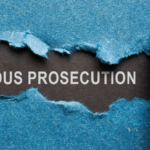‘Noble Cause Corruption’: Police Committing Crimes to Achieve Criminal Convictions

Former New South Wales police detective Gary Jubelin is a hero in the eyes of the mainstream media, having recently be presented on countless news reports and shows such as ’60 Minutes’ and ‘Under Investigation’ as not just an expert in criminal investigation but a respectable law enforcement officer.
Jubelin was the lead detective in the case of missing three-year old William Tyrell, who disappeared from Kendall on the Mid North Coast of New South Wales on 12 September 2014.
During that investigation, the detective engaged in criminal conduct by recording a ‘person of interest’ at the time, Paul Savage, on multiple occasions without a warrant in flagrant breach of the Surveillance Devices Act 2007.
He was charged with four counts of illegally using a listening device to record a private conversation and was ultimately convicted of each of those charges. He lodged an appeal to the District Court but it was unsuccessful, and the convictions were confirmed.
Jubelin’s case was a rare instance of a police officer being prosecuted for crimes committed ostensibly in pursuance of a criminal conviction.
Having failed to implicate Mr Savage and with the objective of obtaining a conviction and thereby appeasing the public, Jubelin and his fellow officers concocted a plan to “crack” an innocent man, William (Bill) Spedding; in other words, to put so much pressure on him that he would provide information regarding young William’s disappearance.
That plan involved, among many other things, bringing bogus historical child sexual assault charges against the washing machine repairman by “coaching” complainants to fabricate non-existent events, before fronting the media to present him as a paedophile.
Police undertook numerous exhaustive searches of Mr Spedding’s property from 2015, emptying his septic tank and digging areas of his property, as well as conducting physical and electronic surveillance. Not a shred of evidence was ever uncovered linking him to young William’s disappearance.
In what can only be seen as an appalling abuse of process, Mr Spedding was nevertheless charged with the child sexual assault offences.
He was acquitted of all charges after a trial in 2018.
Spedding brought civil proceedings for malicious prosecution the next year and, just last week, Justice Harrison of the Supreme Court found in his favour, awarding him nearly $1.5 million in damages plus legal costs.
The judge was scathing in his criticism of the investigators, noting that the child sexual assault charges were, “concocted and false and could not be supported”, and that:
“Mr Spedding’s reputation was comprehensively destroyed as the result of his arrest and prosecution on the historical sexual assault allegations. It is doubtful that it will ever be restored.”
The award included both aggravated and exemplary damages which will, of course, ultimately be paid by New South Wales taxpayers and not by the offending officers.
The relentless pursuit and systematic annihilation of an innocent man was also an act of injustice towards young William and his family, diverting resources from the pursuit of the actual culprit/s.
But Mr Spedding is certainly not the first and, dare it be said, won’t be the last innocent person to be destroyed as a result of crimes, cover-ups and the fabrication or concealment of evidence by law enforcement officers in Australia.
Indeed, many innocent people have been prosecuted for, but convicted of, crimes they did not commit, from the last person to be executed in Australia, Ronald Ryan, to Andrew Mallard, the Mickelberg brothers, John Button and Lindy Chamberlain.
The ‘Lawyer X’ scandal
More recently, the ‘Lawyer X’ scandal revealed the lengths Australian police will go in order to convict persons of interest and suspects of criminal offences. The saga involved Victoria police using a criminal defence barrister, Nicola Gobbo, as a paid informant under threat of criminal prosecution for her own alleged misdeeds providing them with information against her own clients.
Victoria police went to great lengths to conceal this conduct from the public eye, appealing all the way to the High Court of Australia for the suppression of their elicitation of information obtained under duress and therefore unreliable.
The High Court ultimately ruled against the police and was scathing in its assessment of the conduct of the officers involved, including members of the top brass.
Among many other things, the Court remarked:
“Victoria Police were guilty of reprehensible conduct in knowingly encouraging EF [‘Lawyer X’] to do as she did and were involved in sanctioning atrocious breaches of the sworn duty of every police officer to discharge all duties imposed on them faithfully and according to law without favour or affection or ill-will.”
“… the prosecution of each convicted person was corrupted in a manner which debased fundamental premises of the criminal justice system”.
Indeed, the conduct of police not only undermined the integrity of the criminal justice system but also confidence in the legal profession, with clients becoming more hesitant to disclose information to their lawyers.
And so it is: the act of what is sometimes termed ‘noble cause corruption’ or ‘noble cause justice’ – conduct which is often not noble or just at all; undermining the presumption of innocence, the right to a fair trial and the rule of law, and potentially resulting in gross injustice.
What is noble cause corruption?
Noble cause corruption involves use of illegal or unethical means to achieve desirable outcomes.
It is therefore grounded in the idea of teleology – that the ultimate goal, aim or end is of paramount importance and the origins, actions and steps that bring about that objective are of little or no relevance.
In the context of the criminal justice process, a belief in the principle would justify the use of unethical or illegal conduct to bring about finality in a case which, in the eyes of law enforcement agents, is most commonly a criminal conviction.
Advocates of the idea would posit that it is justified, appropriate or even warranted to engage in offences against public justice such as tampering with evidence, perjury, influencing witnesses and/or perverting the course of justice provided this leads to the conviction of a perpetrator.
They would also argue that engaging in unlawful conduct during the investigation process (such as illegally recording conversations), concealing evidence from the defence and even fabricating evidence is justified as long as the person who committed the offence is convicted.
The problem with noble cause corruption
The overriding problem with such a view is that many rules viewed as inconvenient by law enforcement agents are there for a very good reason – to ensure the ultimate goal of justice is achieved – and ignoring those rules can, and often does, lead to justice being undermined, as it was in the case of Mr Spedding and many others.
Safeguards contained in the common law and various pieces of legislation have evolved over hundreds of years, and their objectives include ensuring that individuals are not deprived of their liberty without sufficient reason, that all probative material is made available in order to enable a proper assessment of the veracity of allegations and that only reliable evidence is used in criminal proceedings.
The ultimate objective is to achieve just outcomes, and the unacceptability of unjustly accusing let alone convicting an innocent person of a criminal offence has been emphasised by both philosophers and jurists for hundreds of years.
There is a good reason that in the 1760s, renowned jurist William Blackstone stated: “It is better that ten guilty persons escape than that one innocent suffer”.
The reason, of course, is that the impact on an innocent person is grave to the extent of being abhorrent.
So-called ‘noble cause corruption’ significantly increases the likelihood of such an unacceptable outcome.
Safeguard against the use of improperly or illegally obtained evidence
In terms of the use of improperly or illegally obtained evidence in criminal proceedings, section 138 of the Evidence Act 1995 (NSW) contains a qualified provision for exclusion.
The section is headed, ‘Discretion to exclude improperly or illegally obtained evidence’ and its first subsection reads:
“(1) Evidence that was obtained:
(a) improperly or in contravention of an Australian law; or
(b) in consequence of an impropriety or of a contravention of an Australian law;
is not to be admitted unless the desirability of admitting the evidence outweighs the undesirability of admitting evidence that has been obtained in the way in which the evidence was obtained.”
There are equivalent provisions in all other states and territories, but it might be noted the provision does not go as far exclusionary rules in many of the United States where there is a presumption that such evidence is liable to exclusion. And, of course, the safeguard presumes the misconduct is detected and exposed.
Subsection (3) proceeds to outline a non-exhaustive list of the matters a court must take into account when determining whether to exercise its discretion to exclude the evidence.
These are:
- the probative value of the evidence; in other words, the extent to which it could affect an assessment of the probability of a fact that is in issue,
- the importance of the evidence in the proceeding,
- the nature of the relevant offence, cause of action or defence and the nature of the subject-matter of the proceeding (generally, the likelihood of admitting the evidence will increase with the seriousness of the offence),
- the gravity of the impropriety or contravention,
- whether the impropriety or contravention was deliberate or reckless,
- whether the impropriety or contravention was contrary to or inconsistent with a right of a person recognised by the International Covenant on Civil and Political Rights,
- whether any other proceeding (whether or not in a court) has been or is likely to be taken in relation to the impropriety or contravention, and
- the difficulty (if any) of obtaining the evidence without impropriety or contravention of an Australian law.
The court is required to balance these factors when reaching its decision, and there have been numerous cases where this has led to the exclusion of evidence.
For example on 5 February 2020 in the case of Kadir v The Queen, the High Court of Australia found that where the gravity of a breach is “very high” the evidence derived as a result will generally be excluded despite its probative value being “very high” and the charges being “very serious”; ruling that surveillance material obtained in breach of the Surveillance Devices Act was inadmissible
The Court also made clear in that case the onus is on the prosecution to establish on the balance of probabilities that improperly or illegally obtained evidence is nevertheless admissible.






